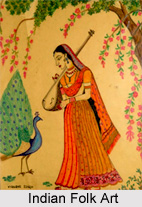 Bhana is solo form of Sanskrit theatre presenting the exploits of a rogue i.e. dhurta in one act comprising a variety of incidents not progressively developed. Typically bhana is a learned and expert vita i.e. a parasitic companion of a dissolute young man or of a courtesan who is skilled in singing, music, and poetry, on familiar terms with his associate whom he virtually serves as a vidushaka. He described his own or others` experiences. Bhana suggested the sringara (erotic) and vira (heroic) rasas, but evoked laughter and satire. The playwright had to invent the theme and generally employed the bharati, vritti, sometimes the kaisiki or graceful too. Consequently, bhana texts abounded in verbal description, improvised further by the performer. They contained all ten lasyangas i.e. feminine components of dance. G. H. Tarlekar described the basic of the *Natyasastra, which can be mentioned as follows:
Bhana is solo form of Sanskrit theatre presenting the exploits of a rogue i.e. dhurta in one act comprising a variety of incidents not progressively developed. Typically bhana is a learned and expert vita i.e. a parasitic companion of a dissolute young man or of a courtesan who is skilled in singing, music, and poetry, on familiar terms with his associate whom he virtually serves as a vidushaka. He described his own or others` experiences. Bhana suggested the sringara (erotic) and vira (heroic) rasas, but evoked laughter and satire. The playwright had to invent the theme and generally employed the bharati, vritti, sometimes the kaisiki or graceful too. Consequently, bhana texts abounded in verbal description, improvised further by the performer. They contained all ten lasyangas i.e. feminine components of dance. G. H. Tarlekar described the basic of the *Natyasastra, which can be mentioned as follows:
Geyapada: song by the vocalist, seated, and accompanied by instrumental music.
Sthitapathya: a woman separated from her lover and suffering pangs of love recites in Prakrit, full of sentiment.
Asina: song of sorrow and anxiety rendered in a seated posture without instrumental accompaniment.
Pushpagandika: songs and dances performed by a woman but accompanied by male movements.
Pracchedaka: a woman who, afflicted by moonlight and thus excited by passion, clings to her lover even if he has done wrong.
Trimudhaka: even metres full of manly states and composed of delicate diction.
Saindhavaka: representation, using Prakrit, of a lover who failed to keep an appointment.
Dvimudhaka: song of caturasrapada in four lines, each repeating the same tala pattern, full of sentiment and emotive states, used for striking effect. Afterwards, according to Abhinavagupta, the performer steps in four directions.
Uttamottamaka: composition in various metres with many sentiments of he la and hava i.e. the delicate expressions of feminine love.
Uktapratyukta: combination of speech and counter-speech due to pleasure or anger, containing censure, set to music.
The actor wore make-up only once i.e. ekaharya and performed many roles. He used the ingenious device of akasabhashita i.e. `aerial discourse`. To accost, speak, and reply as if addressing one actually present, making rejoinders, and quoting the supposed speech of another. Thus bhana presented a challenge to perform various characters and incidents singly, because its nature as a monodrama could have rendered it monotonous. Only a performer fully trained in abhinaya, music, and dance could have succeeded in it. Moticandra`s edition of very old texts titled Caturbhani may best illustrate this form.




















